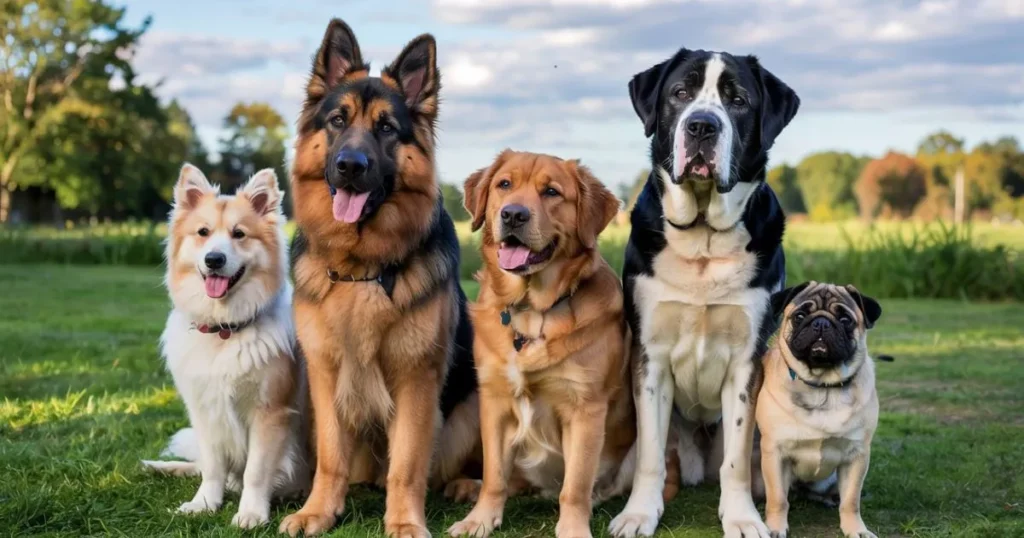Finding the Perfect Companion: Why Dog Breeds Matter
Imagine coming home after a long day to a wagging tail and a joyful bark. Your dog isn’t just a pet; they’re a companion, a confidant, and a source of unconditional love. But choosing the right dog isn’t always straightforward. With so many breeds, each with unique traits and needs, how do you find the one that’s the perfect fit for your lifestyle?
Understanding the different types of dogs and their characteristics can help you make an informed decision. Whether you’re seeking a playful partner for your morning jogs or a calm companion for cozy evenings at home, knowing the breed’s energy levels, grooming requirements, and temperament is crucial.
In this guide, we’ll explore various dog breeds, categorized by their original purposes and traits, to help you find the ideal match for your home and heart.
What Are Dog Breeds? Understanding Canine Diversity
Definition of a Dog Breed
A dog breed is a group of dogs with similar characteristics, such as appearance, behavior, and purpose. These traits are passed down through generations, often intentionally, to fulfill specific roles like herding livestock, guarding property, or providing companionship.
Why Breed Characteristics Matter
Each breed has distinct qualities that can influence your experience as a dog owner. For instance:
- Behavior Traits: Some breeds are naturally more independent, while others are eager to please.
- Energy Levels: Active breeds may require more exercise and mental stimulation.
- Grooming Needs: Long-haired breeds might need regular brushing, while short-haired ones are easier to maintain.
- Health Considerations: Certain breeds are prone to specific health issues, so understanding these can aid in preventive care.
Major Dog Groups Explained

Working Dogs
Originally bred to perform tasks like guarding, pulling sleds, or rescuing, working dogs are strong, intelligent, and protective.
- Key Breeds: Rottweiler, Doberman Pinscher, Boxer, Siberian Husky
- Traits: Loyal, alert, requires consistent training
- Ideal For: Active individuals or families with experience in dog training
Herding Dogs
Herding dogs were developed to manage livestock. They’re intelligent, energetic, and thrive on having a job to do.
- Key Breeds: Border Collie, Australian Shepherd, German Shepherd
- Traits: Highly trainable, energetic, may try to herd children or other pets
- Ideal For: Active families or individuals with experience in dog training
Sporting Dogs
Sporting dogs were bred to assist hunters in retrieving game. They’re friendly, energetic, and love activities like fetch.
- Key Breeds: Labrador Retriever, Golden Retriever, Cocker Spaniel
- Traits: Friendly, loves water, requires regular exercise
- Ideal For: Families, active individuals, or those who enjoy outdoor activities
Toy Breeds
Toy breeds are small in size but big in personality. They’re affectionate, adaptable, and often do well in apartments.
- Key Breeds: Chihuahua, Pomeranian, Shih Tzu
- Traits: Affectionate, low exercise needs, may be vocal
- Ideal For: Apartment dwellers, seniors, or those seeking a lap dog
Terrier Group
Terriers were originally bred to hunt vermin. They’re feisty, energetic, and often have a strong prey drive.
- Key Breeds: Jack Russell Terrier, Bull Terrier, Scottish Terrier
- Traits: Energetic, bold, may be stubborn
- Ideal For: Experienced dog owners or active individuals
Hound Group
Hounds were bred for hunting due to their exceptional scenting abilities or speed. They’re independent and have a strong prey drive.
- Key Breeds: Beagle, Bloodhound, Greyhound
- Traits: Independent, strong sense of smell or sight, may be vocal
- Ideal For: Active individuals or those with experience in dog training
Non-Sporting Group
This diverse group includes breeds that don’t fit into the other categories. They vary widely in size, coat type, and temperament.
- Key Breeds: Bulldog, Dalmatian, Poodle
- Traits: Varied, may require specific grooming or exercise needs
- Ideal For: Families or individuals seeking a unique breed
Choosing the Right Breed for Your Lifestyle
When selecting a dog, consider factors like your living situation, activity level, and experience with dogs.
- Home Size: Larger breeds may need more space, while smaller breeds can adapt to apartment living.
- Activity Level: Active breeds require more exercise; sedentary breeds may be content with short walks.
- Experience: Some breeds are easier for first-time owners, while others may require experienced handlers.
Mixed Breeds and Designer Dogs
Mixed Breeds
Mixed breeds, often referred to as mutts, are dogs with ancestry from multiple breeds. They can inherit a combination of traits, leading to unique appearances and temperaments.
- Pros: Often healthier due to genetic diversity, unique personalities
- Cons: Traits can be unpredictable, may inherit health issues from any parent breed
Designer Dogs
Designer dogs are intentionally bred by crossing two purebred dogs to achieve specific traits.
- Examples: Labradoodle (Labrador Retriever + Poodle), Puggle (Pug + Beagle)
- Pros: May combine desirable traits from both breeds
- Cons: Can be expensive, may inherit health issues from either parent breed
Health, Care, and Longevity by Breed Type
Different breeds have varying health considerations and life expectancies.
- Small Breeds: Often live longer, may have dental issues
- Large Breeds: Shorter life expectancy, may have joint problems
- Mixed Breeds: Generally healthier, but can inherit breed-specific issues
Regular veterinary check-ups, a balanced diet, and appropriate exercise are essential for all dogs.
Most Popular Dog Breeds in the World
According to the American Kennel Club, some of the most popular breeds include:
- Labrador Retriever: Known for their friendly and outgoing nature
- French Bulldog: Small, affectionate, and adaptable
- German Shepherd: Intelligent, versatile, and protective
- Golden Retriever: Friendly, reliable, and trustworthy
Conclusion: The Right Dog Is Out There For You
Choosing the right dog breed is a significant decision that should align with your lifestyle, preferences, and capabilities. By understanding the characteristics and needs of different breeds, you can find a companion that fits seamlessly into your life.
Remember, every dog is an individual, and while breed characteristics provide a general guideline, each dog has its unique personality. Spend time with potential breeds, ask questions, and consider adopting from shelters where many wonderful mixed-breed dogs are waiting for a loving home.
Frequently Asked Questions About Different Types of Dogs
What are the main types of dogs?
Dogs are typically classified into groups such as Working, Herding, Sporting, Toy, Terrier, Hound,
